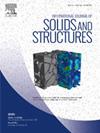空间可展开结构高应变复合材料粘弹性-粘塑性建模
IF 3.4
3区 工程技术
Q1 MECHANICS
International Journal of Solids and Structures
Pub Date : 2024-11-28
DOI:10.1016/j.ijsolstr.2024.113154
引用次数: 0
摘要
由薄层纤维增强复合材料层压板制成的空间可展开结构在整个使用期间表现出显著的随时间变化的力学行为,包括应力松弛、形状恢复和永久残余变形。目前,缺乏一种合适的复合材料层压模型,能够充分描述这些现象。在这里,我们通过提出一个各向异性粘弹粘塑性连续本构模型来解决这一差距,以捕捉复合材料可展开结构在折叠、积载、展开和恢复期间的力学行为。该模型采用基于玻尔兹曼积分的粘弹性公式和希尔型速率相关粘塑性公式。给出了一种采用两步粘弹性预测和粘塑性校正策略的全隐式积分的详细数值实现方案。通过对单向板和编织板的实验结果验证了该模型的准确性和有效性。模拟准确捕捉了不同离轴加载方向下单层板循环加卸载试验中速率相关的非线性应力-应变响应、恒应力下的蠕变响应和滞回线。重要的是,所提出的方法是第一个捕获实验观察到的真实复合材料可展开结构的永久变形,并通过柱弯曲试验进行验证。这种先进的建模和仿真能力大大提高了空间可展开结构的仿真和设计。本文章由计算机程序翻译,如有差异,请以英文原文为准。
Modeling viscoelasticity–viscoplasticity of high-strain composites for space deployable structures
Space deployable structures made of thin-ply fiber-reinforced composite laminates exhibit significant time-dependent mechanical behaviors, including stress relaxation, shape recovery, and permanent residual deformation throughout their service period. Currently, there is a lack of an appropriate composite laminate model that is able to fully describe these phenomena. Here, we address this gap by proposing an anisotropic viscoelastic–viscoplastic continuum constitutive model to capture the mechanical behavior of composite deployable structures during folding, stowage, deployment, and recovery periods. The model adopts a viscoelastic formulation based on the Boltzmann integral, coupled with a Hill-type rate-dependent viscoplastic formulation. A detailed numerical implementation scheme using fully implicit integration with a two-step viscoelastic predictor and viscoplastic corrector strategy is provided. The accuracy and efficiency of the proposed model are validated against experimental results for both unidirectional and woven laminates. Simulations accurately capture the rate-dependent nonlinear stress–strain response, creep response under constant stress, and hysteresis loops in cyclic loading-unloading tests for single-ply lamina under various off-axis loading directions. Importantly, the proposed method is the first to capture the experimentally observed permanent deformation of real-world composite deployable structures, validated through column bending tests. This advanced modeling and simulation capability significantly enhances the simulation and design of space deployable structures.
求助全文
通过发布文献求助,成功后即可免费获取论文全文。
去求助
来源期刊
CiteScore
6.70
自引率
8.30%
发文量
405
审稿时长
70 days
期刊介绍:
The International Journal of Solids and Structures has as its objective the publication and dissemination of original research in Mechanics of Solids and Structures as a field of Applied Science and Engineering. It fosters thus the exchange of ideas among workers in different parts of the world and also among workers who emphasize different aspects of the foundations and applications of the field.
Standing as it does at the cross-roads of Materials Science, Life Sciences, Mathematics, Physics and Engineering Design, the Mechanics of Solids and Structures is experiencing considerable growth as a result of recent technological advances. The Journal, by providing an international medium of communication, is encouraging this growth and is encompassing all aspects of the field from the more classical problems of structural analysis to mechanics of solids continually interacting with other media and including fracture, flow, wave propagation, heat transfer, thermal effects in solids, optimum design methods, model analysis, structural topology and numerical techniques. Interest extends to both inorganic and organic solids and structures.

 求助内容:
求助内容: 应助结果提醒方式:
应助结果提醒方式:


